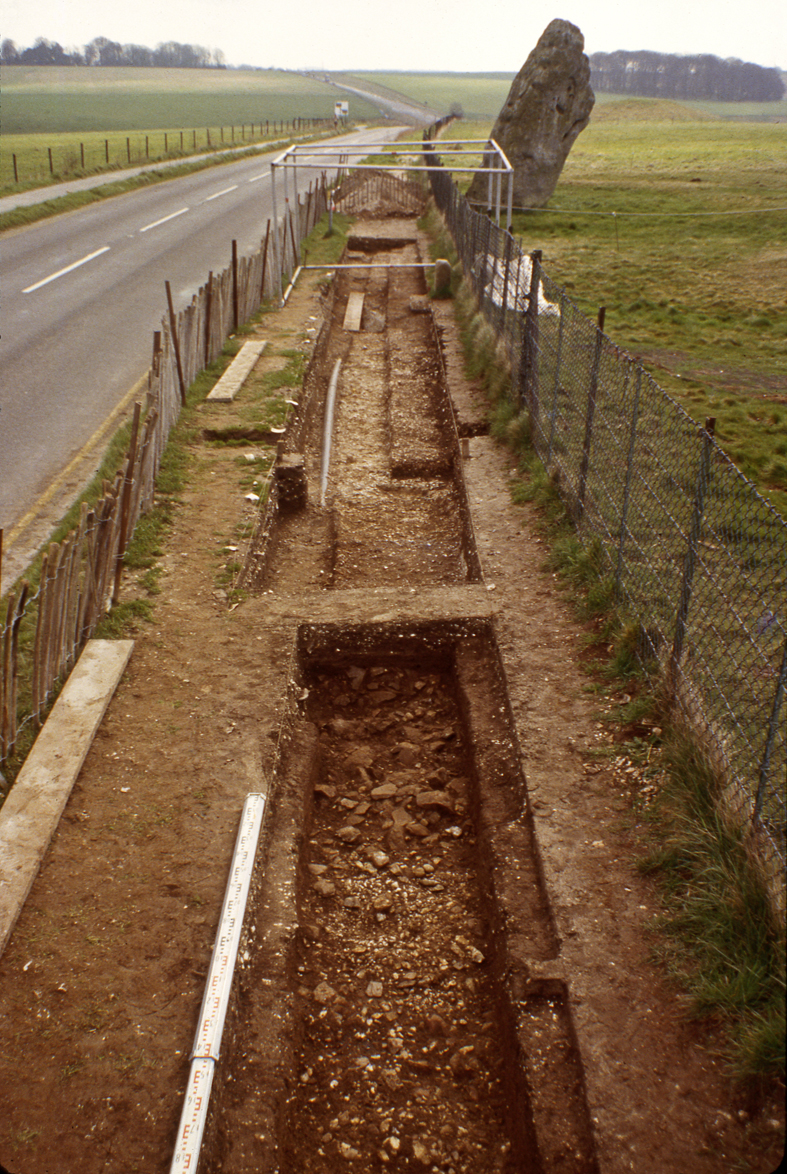If you visit Stonehenge now – as huge numbers did in August – you’ll really see signs that things are changing. Work continues in the car park to prepare a turning circle at the end of what will be the stub of the old A344. The road itself as it once continued eastwards to Stonehenge Bottom has now all but gone, exposing the chalk below. Wessex Archaeology has been monitoring it, and has excavated parts of the two parallel Avenue ditches, and a small part of what looks like the lip of the Heelstone ditch, as Ollie Good kindly showed me.
My interest in this was naturally strengthened by my excavations immediately beside the road there in 1979 and 1980. We had several advantages over the modern archaeologists.
The team were almost all volunteers, archaeology students and staff from Southampton University, so brought considerable skill, but at no cost to the Department of the Environment, which was technically running the show, through me as its employee directing the digs. The areas we excavated were by comparison very small. Though the long, narrow nature of the trenches brought its own problems, their scale, and no cost restrictions on labour, meant we were able to hand excavate the entire thing, including cleaning all the “natural’ by hand. All artefacts excavated within features were plotted in 3D, and we recorded over 20 vertical sections.
The Stone Floor in 1980 was so dense, we excavated that in 1m-long segments, and wet-sieved all the soil, though note my comment in the report on this: “Individual treatment of finds from the Stone Floor was felt to be quite inappropriate for the vast quantity and frequently minute size of the material recovered. Contemporary opinion had led one to expect accumulations of Stonehenge rock filling hollows and wheel ruts in recent road surfaces. However, detailed post-excavation analysis has strongly indicated the deposit to be prehistoric. Any future exposure of similar features should, without question, be recorded in greater detail.”
By comparison, Wessex has a large area – as large as it ever gets near to Stonehenge – and time and resources are subject to a contract with English Heritage. Over 30 years ago, senior archaeologists were doubtful that anything much of worth would be found under the road verge. They were wrong. But today, there could have been little question that anything of interest once near the surface (such as an equivalent to the Stone Floor) would have been at least partly removed by the road, which was sunk in a slight hollow.
So no great surprise, perhaps, to find that little seems to have been revealed beyond the Avenue ditches and the Heelstone ditch, though with some interesting features that may be part of the early road (which contrary to an old saw in some news reports, has been there since the 18th century, not eternity). Down by the car park is a curious stone-lined floor-like feature, which is apparently thought to be relatively modern.
The surface geology at Stonehenge is complex. I’m not sure the stone pit we excavated in 1979, whose fill was very similar to the surrounding cryoturbated chalk, would have been found had we not been able to excavate it slowly by hand, and spend a lot of time staring at it.

- Near end of 1979 dig, with army lorries and the Stonehenge Free Festival in the Cursus field. Excavated Avenue ditch just visible in near end of trench





Starlings flock at Stonehenge: but soon the fences, and the food, around the car park will be gone.




There’s a photo from 1979, with the Peoples Free Festival “in the Cursus Field”. I’d like to point out that the Cursus itself runs on the other side of the barrows (behind them), and the Free Festival never encroached upon the Cursus itself, to the best of my knowledge and belief. Other than that, it’s a really good photo, and thank you for making it available here. Nice work with the archaeology, too.